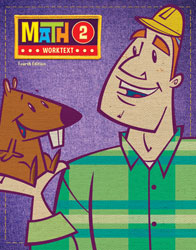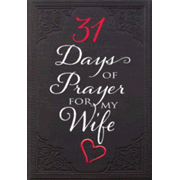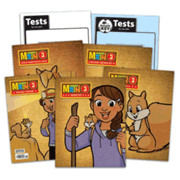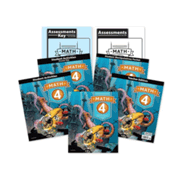BJU Press's math curriculum for kindergarten through sixth grade was written for use in classrooms, but it is easy for homeschooling parents to teach. The courses include biblical worldview discussions that are more plentiful beginning with Math 2.
The math courses are available online, but this review focuses on textbook-based courses without the video component.
The curriculum is designed to be taught from the Teacher's Editions using manipulatives, activities, and interactive discussion. The fourth and fifth editions of these courses emphasize teaching children to explain their answers and the mathematical reasoning they use for problem solving. Some of the fourth and all of the fifth editions also offer four or more STEM or STEAM activities per grade level. (The fifth editions are written with increasing awareness of state standards.) Otherwise, changes from previous editions are minor.
These courses teach both conceptual understanding and mastery of math facts. They do an excellent job of presenting concepts in a variety of ways to reach students with different learning styles and abilities. Math facts are emphasized in grades one through four with daily practice. Extra fact practice is available with the Fact Reviews and the Reviews/Activities book in grades one through five.
Teacher's Editions provide complete instructions for teaching each course. The courses are presented in chapters, with several lessons within each chapter. An introductory page for each chapter outlines objectives for each of the lessons. Then the Teacher's Editions provide step-by-step scripts for what the teacher is to say and do for each lesson. They also include reduced reproductions of Student Worktext pages with overprinted answers.
The fourth editions of these courses introduce relatively new math terms and methods that might be unfamiliar to some teachers. One of them, the ten frame, has become a common visual aid used in math programs in recent years. These courses also use two newer terms that are sometimes used in reference to the ten frame but also in other instances: composing and decomposing. The Oxford Owl website presents a simple explanation: "Composing numbers refers to joining groups or a set of numbers to make another number, while decomposing numbers means to break numbers down to their component parts."
These courses are dependent upon a teacher's presentation. Students have their own worktext for each course that is used for practice and reinforcement. Worktexts in other programs usually provide both instruction and problem-solving practice. Since in these BJU Press courses much learning occurs through activity and discussion, worktext learning is a lesser part of each lesson. You cannot just give the student the worktext without first teaching the lesson.
The student worktexts are colorful, appealingly illustrated, and include a Chapter Review to help students prepare for the test. Many grade levels also include a Cumulative Review for each chapter. The worktexts in grades one through five are perforated for easy removal of the pages.
Courses for grades one through three each have a Reviews workbook with two pages per day of additional practice on concepts taught in that day's lesson, concepts and skills from prior lessons, and math facts. Math 4 and Math 5 have a similar book, titled Activities.
An inexpensive Student Manipulatives Packet adds elements for hands-on learning up through fourth grade, and each student should have his or her own packet. (Most manipulatives are printed on heavy card stock. This keeps the cost down, but you might prefer plastic manipulatives for some of them since plastic pieces are easier to handle and last longer.) Booklets of tests are sold separately, as are their corresponding answer-key booklets.
Teaching resources are available on BJU Press's Homeschool Hub, including a platform for scheduling and tracking work in BJU Press courses. It also has printable pages to be used for instructional aids, student enrichment, extended practice, and fact review activities. Some courses include calculator activities or reproducibles for manipulatives that are not in the Student Manipulatives Packets. The Teacher's Editions and Homeschool Hub both list resources needed for each lesson.
Subject Kits for each level include a Teacher's Edition, a Student Worktext, a Student Manipulatives Packet for up through Math 4, a Review or Activities book (for grades one through five), a Tests booklet, and a Tests Answer Key. If you choose to buy items individually and want to save money, the publisher offers suggestions for substitute and make-it-yourself manipulatives. These suggestions can be found either in the Teacher's Edition or online.
Math K5 (fourth edition)
BJU Press's K5 math course is designed to build a foundation for understanding math concepts, starting at the kindergarten level. At the beginning, it teaches number and quantity recognition, how to write numbers, and counting. It goes on to teach numbers up through 100, beginning addition and subtraction, an introduction to fractional parts (e.g., one-half), geometric shapes, time, the calendar, money, and measurement.
Stories at the beginning of each chapter feature Farmer Brown, his wife, and Cheddar the mouse. These characters and the farm theme are used frequently throughout the course.
Manipulatives play an important role in introducing new concepts at this level. The same set of manipulatives is used for both the kindergarten and first-grade courses. It contains geometric shapes, fraction pieces, play money, a hundred chart, number cards, mathematical operations sign cards, dot-pattern cards, rulers, ten bars, ten frames, and place-value pieces.
Children will also complete worksheets from their Student Worktext that require them to write numbers, circle items, draw connecting lines, and color. Frequent review is included.
The subject kit includes the Teacher's Edition, the Student Worktext, and the Student Manipulatives Packet. There are no tests for kindergarten.
Math 1 (fourth edition)
This first-grade course teaches concepts such as place value, addition, subtraction, problem solving, time, money, simple geometry, and fractional parts. In the fourth edition, BJU Press has added a full chapter on data that includes work with tally charts, picture graphs, and bar graphs. The final chapter reviews most concepts taught in the course.
Each chapter begins with a story featuring Digit the clown and Cecilia the seal.
The same Student Manipulatives Packet is used for both kindergarten and first grade. See the list of items in the kit under Math K5.
Math 2 (fifth edition)
The adventures of Matt O'Malley and his sidekick Paddy the beaver are featured in images at the beginning of each chapter and in stories presented from the Teacher Edition.
Biblical worldview concepts are prominent in every chapter and are included in the objectives.
Math 2 continues teaching place value, addition, and subtraction (up through four-digit numbers), while also introducing multiplication (single-digit multipliers) and division, two-step word problems, money, fractions, measurement, and problem solving using information from graphs and charts. Coding at a very introductory level is introduced in four "STEM" lessons within Chapters 4, 8, 12, and 16, and the final chapter is entirely about coding (algorithms, conditional statements, and the binary system).
This course continues to use manipulatives to engage students in the learning process. The Student Manipulatives Packet includes a place value mat and pieces, number cards, sign cards, rulers, thermometers, shapes, theme character figures, money cut-outs, fraction pieces, and fact cards. Instructional aids in the teacher edition are essential for lesson presentations.
Continual review is built into the worktext activities and the separate Math 2 Reviews workbook. In addition, Practice & Review activities and Extended Activities are directed from the teacher edition.
Math 3 (fourth edition)
Math 3 features stories about Hailey and her pet squirrel Horatio. The course covers multiplication up through 10 x 10, division with one-digit divisors, and briefly teaches the concept of remainders. Students should master their multiplication and division facts this year.
Math 3 also does quite a bit of work with fractions and decimals. Lots of word problems help develop application skills. This course continues to incorporate the ten frame, number lines, a hundred chart, a place value chart, rectangular arrays for multiplication, and other visual aids to teach concepts in a variety of ways. The final chapter is dedicated to review.
Students will use manipulatives, although to a lesser extent than in the earliest levels of BJU Press's program. The Student Manipulatives Packet for this level includes counters, geometric shapes, number cards, a place value mat and pieces, fraction pieces, money cut-outs, a clock, rulers, and thermometers.
Math 4 (fourth edition)
Students continue to use manipulatives with this course as they study multiplication, division, fractions, decimals, geometry, time, measurement, graphs, and metric measurements. The final chapter on pre-algebra introduces positive and negative numbers and the coordinate graph with ordered pairs. Sixteen STEAM lessons are included.
Stories at the beginning of each chapter follow the adventures of Captain Bailey and his search for a priceless silver medallion.
The Student Manipulatives Packet for Math 4 includes geometric shapes, a clock, a thermometer, number cards, fraction pieces, money cut-outs, a place value mat and pieces, measurement flashcards, and multiplication/division cards. (This course has very few changes from the third edition.)
Math 5 (fourth edition)
Math 5 reviews basic operations, expands work with fractions and decimals, and includes STEM activities. It also teaches number concepts (e.g., positive and negative numbers), metric measurement, geometry (surface area and volume), ratios, proportions, percents, and how to work with data and graphs. Technology concepts are taught from the teacher edition.
An aviation theme is used throughout the text. The Teacher's Toolkit includes "Biblical Worldview Shaping" instructions and activity pages; these activities relate to the chapter theme while bringing a Christian worldview to bear on real-life situations.
Math 6 (fourth edition)
Math 6 reviews addition, subtraction, multiplication, division, fractions, decimals, and percents, and teaches about ratio, proportions, probability, two- and three-dimensional geometric figures, and various ways to present and analyze data. STEM lessons are included, and Biblical worldview concepts are taught throughout the course. The course uses a spiral approach for practice and review.

















